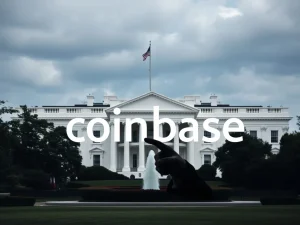Revolutionary CEX Listing? Binance CZ’s Bold DEX Model Suggestion Sparks Concerns

Changpeng Zhao (CZ), the influential CEO of Binance, ignited a firestorm of discussion within the crypto community with a rather provocative suggestion. He proposed that centralized exchanges (CEXs) should immediately adopt a listing approach akin to decentralized exchanges (DEXs). This audacious idea, while seemingly aimed at streamlining token access, has raised eyebrows and sparked significant concerns across the digital asset landscape. Is this a visionary leap forward, or a step towards potential chaos? Let’s delve into the heart of this intriguing proposition and explore its implications for the future of crypto trading.
Why is CZ suggesting a DEX-like CEX listing process?
CZ’s critique centers around the perceived inefficiencies and vulnerabilities inherent in the current CEX listing methodologies. He argues that the traditional, often lengthy and gatekeeper-driven, processes employed by centralized platforms are breeding grounds for price manipulation. In a rapidly evolving market where new tokens are launched at an astonishing pace, the bottleneck created by these processes can lead to artificial scarcity and inflated valuations. CZ’s perspective is rooted in the belief that democratizing the listing process, making it more open and less centralized, could potentially mitigate these issues.
To understand the context, let’s consider the contrasting approaches:
- Traditional CEX Listing: Typically involves a rigorous application and vetting process. Projects often pay substantial listing fees and undergo extensive due diligence. This process can be time-consuming and expensive, acting as a barrier to entry for newer or smaller projects.
- DEX Listing: Characterized by permissionless and often automated listing. Projects can list their tokens on DEXs with minimal hurdles, primarily needing to provide liquidity. This approach is faster, cheaper, and more accessible.
CZ’s suggestion essentially advocates for CEXs to emulate the speed and openness of DEX listing while presumably retaining some level of oversight to safeguard users. But is this even feasible, or desirable?
The Potential Benefits of a Faster Crypto Exchange Listing
Embracing a more DEX-like crypto exchange listing process within CEXs could unlock several potential advantages:
- Increased Token Accessibility: A streamlined listing process would mean new and promising tokens could reach a wider audience faster. This could foster innovation and accelerate the growth of the crypto ecosystem.
- Reduced Listing Fees: The hefty listing fees charged by some CEXs can be a significant burden for projects. A shift towards a more automated or less stringent process could potentially lower or eliminate these fees, making it more economically viable for projects to list.
- Enhanced Market Efficiency: By reducing gatekeeping, a faster token listing process could lead to more efficient price discovery. Tokens would be available for trading sooner, potentially curbing artificial price pumps and dumps associated with delayed listings.
- Greater Innovation: Lower barriers to entry could encourage more projects to launch and experiment, fostering a more vibrant and dynamic crypto space.
Imagine a scenario where promising new projects, regardless of their size or backing, can quickly gain access to the vast user base and liquidity of major CEXs. This could be a game-changer for the industry, fueling innovation and expanding the reach of decentralized technologies.
Navigating the Challenges: Concerns and Potential Pitfalls
While the prospect of a rapid crypto exchange listing is enticing, it’s crucial to acknowledge the significant challenges and concerns that accompany such a radical shift:
- Increased Risk of Scam Tokens: A less rigorous vetting process could open the floodgates to scam projects and low-quality tokens. DEXs are already facing challenges with rug pulls and fraudulent schemes. Replicating this model on CEXs, without robust safeguards, could amplify these risks for mainstream users who trust CEXs for security.
- Liquidity Fragmentation: While CZ mentions liquidity strains, a rush of new listings without proper due diligence could actually exacerbate liquidity fragmentation. Too many tokens vying for attention and trading volume might dilute liquidity across the board.
- Regulatory Scrutiny: Regulators are already closely examining CEX listing practices. Moving towards a less controlled approach might attract even greater regulatory scrutiny and potentially lead to stricter compliance requirements down the line.
- Operational Overload for CEXs: Even with automation, handling a massive influx of new listings would place a significant operational burden on CEXs in terms of infrastructure, customer support, and monitoring.
The crucial question is: can CEXs effectively balance the benefits of speed and accessibility with the imperative of user protection and market integrity? Simply replicating the DEX model wholesale on CEXs is likely not the answer. A nuanced approach is needed.
Binance CZ’s Vision: A Hybrid Model?
It’s unlikely that CZ envisions a completely permissionless CEX listing process. Binance, and other major CEXs, have built their reputations on a certain level of security and trust. Abandoning all forms of due diligence would be detrimental to their brand and user base.
More likely, CZ is suggesting a hybrid model – one that incorporates elements of DEX-like speed and accessibility while retaining crucial safeguards. This could involve:
- Tiered Listing System: CEXs could introduce different tiers of listings. A faster, more streamlined tier with basic checks for projects willing to accept lower visibility, alongside a more rigorous, traditional tier for projects seeking premium placement and greater user exposure.
- Community Vetting: Leveraging the power of the community to assist in the vetting process. This could involve mechanisms for users to flag suspicious projects or participate in decentralized due diligence initiatives.
- Automated Risk Assessment Tools: Developing and deploying sophisticated AI-powered tools to automatically analyze token contracts, project documentation, and on-chain data to identify potential red flags and risks.
- Enhanced Transparency: Being more transparent about the listing criteria and risk factors associated with different tokens. Empowering users with more information to make informed decisions.
These are just a few potential avenues for innovation. The key is to find a balance that fosters a more dynamic and accessible market without compromising user safety and market stability.
The Road Ahead: Collaboration and Careful Consideration
CZ’s suggestion has undoubtedly injected a much-needed dose of urgency into the conversation around crypto exchange listing practices. The current system, while offering some level of protection, is arguably too slow, too expensive, and potentially stifling innovation. However, a reckless rush towards a completely open and unregulated listing environment would be equally detrimental.
The path forward requires careful consideration, collaboration, and innovation. CEXs, project developers, regulators, and the community at large need to engage in constructive dialogue to forge a new paradigm for token listings – one that is both efficient and secure, accessible and responsible. This is not just about listing tokens faster; it’s about building a more robust, inclusive, and sustainable crypto ecosystem for the future.
Conclusion: A Bold Proposal Demanding a Thoughtful Response
Binance CZ’s call for a DEX-like CEX listing process is a bold and provocative move that has ignited a critical debate within the crypto world. While the potential benefits of faster, cheaper, and more accessible listings are undeniable, the inherent risks cannot be ignored. The industry now faces the challenge of innovating and adapting to find a balanced approach – one that embraces the dynamism of DEXs while upholding the security and trust that users expect from CEXs. The future of token listing is at a crossroads, and the decisions made in the coming months will shape the trajectory of the crypto market for years to come. This is a pivotal moment demanding a thoughtful and collaborative response from all stakeholders.








